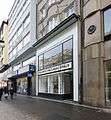František Zelenka
František Zelenka (July 8, 1904 Kutná Hora – October 19, 1944 Auschwitz).[1] was a notable Czech functionalist architect, graphic, stage and costume designer.
Life
Zelenka studied architecture at the Prague Technical University between 1923-28. He was invited to collaborate on theatre stage set designs with Prague theatres: the National Theatre, the Liberated Theatre, the Estates Theatre, the Municipal Theatre in Vinohrady, the Chamber Theatre and with the Comedy Theatre in Smíchov. He also designed for theatres in Brno, Olomouc and Kutná Hora.[2] He worked together with the greatest of the Czech theatre: E. F. Burián, Jiří Frejka, Karel Dostál and with Jiří Voskovec and Jan Werich, during the years of 1926-1941. Zelenka cooperated closely with members of the Czech avant-garde movement Devětsil.[3] In 1931 he had one man exhibition of 39 posters in Krásná jizba gallery in Prague. His posters for the Liberated Theatre of Voskovec and Werich and Aero automobiles combine elements of modern art and advertising. As a member of the Architect's Club and The Artists Union Zelenka designed an exposition for Philips in Pardubice in 1930. His architectural works included family homes and villas in Prague - Smíchov and at Baba Estate and retail/apartment building on Palackého street and another one on Lodecká with Leopold Ehrmann. He also designed furniture and interiors such as the Blue Room for musical composer Jaroslav Ježek in Kaprova street.[4] Zelenka was a designer of shops and interiors such the Josef R. Vilímek Bookshop (now Václav Špála Gallery) on Národní Avenue in Prague. In 1938 he considered emigrating to Switzerland. On July 13, 1943 he is together with his family deported to the Theresienstadt Ghetto. There he organized theatre productions, designed costumes and acted as director. On October 19, 1944 together with his wife Gertruda and eight-year-old son Martin, Zelenka was transported to Auschwitz in occupied Poland.[5] Elsewhere in previous sources the precise date of his death is not given as certain.[6] According to another source[7] Zelenka, and another slave laborer, Joseph Polák, both of whom toiled as catalogers at the Nazi-run Central Jewish Museum, Prague, were deported to the Terezín concentration-death camp and perished spring 1943. Between September 1942 and October 1943, the Jewish slave labor catalogers, including Zelenka, Polák, and curator Tobias Jacobovits, catalogued enormous quantities of the Judaica objects stolen by the Nazis from the Jewish communities of Bohemia and Moravia. The stolen items were for the Nazis planned Museum of the Extinct Jewish Race. At the end of the war, these objects numbered 140,000 items. Jacobovitz was murdered at Auschwitz, October 29, 1944.
Notable works
-
1937–1938 Apartment building, Lodecká 3, Prague with Leopold Ehrmann
-

1938 Vilímek Bookshop, Prague, now Václav Špála Gallery
-
1926 Blue Room of Jaroslav Ježek
See also
References
- ↑ Margolius, Ivan (1996). 'Prague: a guide to twentieth century architecture. London: Ellipsis. p. 302. ISBN 1-899858-18-0.
- ↑ Alborch, Carmen; et al. (1993). The Art of the Aven-Garde in Czechoslovakia 1918-1938. Valencia: IVAM Centre. p. 444. ISBN 84-482-0108-6.
- ↑ Tvrdíková, Lada (2009). Scénograf František Zelenka. Brno: Filosofická fakulta Masarykovy university. p. 90.
- ↑ Kroutvor, Josef (1991). Zelenka: Plakáty, Architektura, Divadlo. Praha: UPM. p. 30. ISBN 80-7101-010-3.
- ↑ Kárný, Miroslav; et al. (1995). Terezínská pamětní kniha 2. Praha: Terezínská Iniciativa. p. 1236. ISBN 80-7023-225-0.
- ↑ Kroutvor, Josef (1991). Zelenka: Plakáty, Architektura, Divadlo. Praha: UPM. p. 54. ISBN 80-7101-010-3.
- ↑ Altschuler, David (1983). The Precious Legacy - Judaic State Treasures from the Czechoslovak State Collections. New York: Simon & Schuster. ISBN 0671494481.
Literature
- Kroutvor, Josef. Zelenka: Plakáty, Architektura, Divadlo, Praha: UPM, 1991, ISBN 80-7101-010-3.
- Tomeš, Josef. Československý biografický slovník, Praha: Academia, 1992, ISBN 80-200-0443-2.
- Margolius, Ivan. Prague: a guide to twentieth century architecture, London: Ellipsis, 1996, ISBN 1-899858-18-0.
- Kohout, Michal et al. Prague: 20th Century Architecture, Praha: Zlatý řez, 1999, ISBN 80-901562-2-3.
- Tvrdíková, Lada. Scénograf František Zelenka, Brno: Filosofická fakulta Masarykovy university, 2009, dissertation.